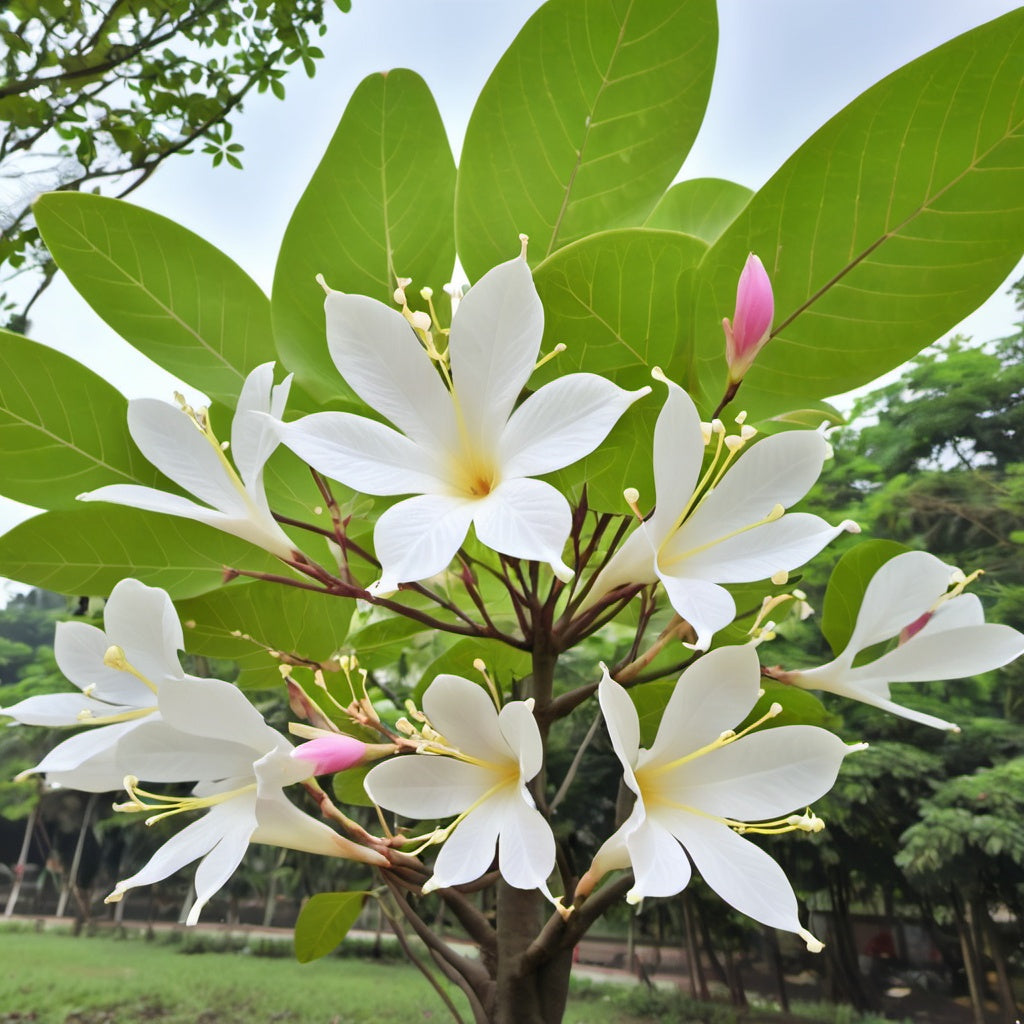White Orchid Tree Seeds
White Orchid Tree Seeds
Couldn't load pickup availability
White Orchid Tree Seeds
(Bauhinia alba)
Bauhinia alba, commonly known as the White Orchid Tree or White Bauhinia, is a beautiful ornamental tree native to Southeast Asia, particularly India and China. It's part of the Fabaceae family and is closely related to other Bauhinia species, such as Bauhinia variegata (which has pink or purple flowers). Bauhinia alba is particularly admired for its white, orchid-like blooms that give it a graceful and elegant appearance.
Key Characteristics
Flowers:
The most striking feature of Bauhinia alba is its large, white, fragrant flowers that resemble orchids. The flowers are typically 3-5 inches wide and bloom in clusters. Each flower has five petals, and they usually appear in winter or early spring, creating a stunning display.
Leaves:
The leaves of Bauhinia alba are unique and often described as "camel's foot" or "butterfly-shaped" because of their distinctive bi-lobed (divided into two lobes) shape. The leaves are about 10-15 cm long, light green, and soft to the touch.
Size and Growth:
Bauhinia alba is a medium-sized deciduous tree, reaching a height of 6-12 meters (20-40 feet) when fully grown. It has a relatively open, spreading canopy, and its trunk is smooth and grayish.
It thrives in warm, tropical, or subtropical climates and prefers well-drained soils.
Uses:
Ornamental: Due to its spectacular flowers, Bauhinia alba is widely planted as an ornamental tree in gardens, parks, and along streets. It’s prized for its ability to beautify spaces with its exotic blooms.
Medicinal: In some traditional systems of medicine, parts of the Bauhinia alba tree (such as its leaves and bark) have been used for their anti-inflammatory and astringent properties, though scientific studies on these uses are limited.
Cultural Significance:
In Hong Kong, a related species, Bauhinia blakeana, is the floral emblem and features on the city's flag and coins. While not the same species, Bauhinia alba shares similar aesthetic and ornamental qualities.
Care and Maintenance:
Bauhinia alba prefers full sunlight and thrives in tropical climates. It’s relatively drought-tolerant but benefits from regular watering, especially during dry seasons.
It’s also sensitive to frost, so in colder climates, it needs protection or to be grown in containers that can be moved indoors.
Ecological Role
While Bauhinia alba is primarily planted for ornamental purposes, its flowers attract pollinators such as bees and butterflies, contributing to local biodiversity. The tree can help enhance garden ecosystems by providing shade and a habitat for small animals and insects.
Overall, Bauhinia alba is a stunning tree that can add beauty and elegance to any tropical or subtropical landscape. Its delicate white flowers and unique leaves make it a popular choice for decorative planting, particularly in urban settings.
Zones: 8 to 11
Stratification Requirement: Seed does not require a pre-treatment. Do not soak in water prior to planting.
Planting Instructions:
Scarify the seeds by rubbing them with sandpaper or nicking them with a knife. This helps water penetrate the seed coat more easily, increasing the likelihood of successful germination.
After preparing the seeds, fill small pots with a well-draining seed-starting mix. A combination of seed starting mix and sand or perlite works well to ensure proper drainage, as white orchid trees do not tolerate soggy soil. Plant the seeds about 1/2 inch deep in the soil, covering them lightly. Water the soil gently but thoroughly, ensuring it is moist but not waterlogged. Place the pots in a warm, sunny location, as these seeds require a warm environment to germinate, typically around 70-85°F (21-29°C). If you live in a cooler climate, using a seedling heat mat can help maintain the ideal temperature.
Germination usually takes between two to four weeks. Keep the soil consistently moist during this period, but be careful not to overwater, which can cause the seeds to rot. Once the seedlings emerge, continue to provide ample sunlight and water as needed, allowing the soil to dry out slightly between watering. When the seedlings have grown large enough to handle, usually after a few months, they can be transplanted to larger pots or directly into the garden in a sunny, sheltered spot with well-draining soil. Be sure to protect the young plants from frost and cold winds, as they are sensitive to low temperatures during their early growth stages.
Share


